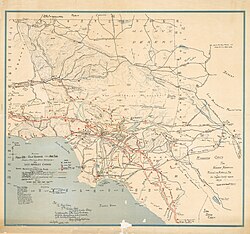Tongva
The Tongva (TONG-vuh) are the indigenous people of the place now known as Southern California. Their original land includes Los Angeles County, Orange County, and the Channel Islands. The Tongva are also known as the Gabrieleño and Fernandeño people based on the missions of San Gabriel and San Fernando built on their land in the 1700s by the Spanish. Tongva means “people of the earth.”[1]
Name
The word Tongva comes from the word Toviscangna, which is a Tongva village located near Mission San Gabriel. However, the Tongva call themselves Kizh (keech).
History
The Tongva were forced onto Spanish missionaries to learn about Christianity and the European lifestyle. The Tongva lived in shelters called kiches. The kiche was dome-shaped. The frame was made of willow branches and was covered with mats made with reeds, grasses, or animal hides. The Tongva lived in villages with as many as 400–500 kiches. A chief lived in the largest kiche and had almost total authority over the village. The position was passed down through the chief’s family.[2]
Culture
The Tongva hunted, fished, and gathered food. They liked to eat acorns. They would mash the acorns and then process it so that it would taste better. They also hunted deer and small animals such as birds, rabbits, and rodents.
Language
The Tongva once spoke the Tongva language but most of them now speak English and Spanish. However, they are trying to use the Tongva language more. One way they are doing this is by having Tongva classes.
The Tongva language was the source of many place names in the Los Angeles region. Some of these places are: Topanga, Tujunga, Cucamonga, etc.
Tongva Media
George W. Kirkman's 1938 historical map of pre-1860 Los Angeles County shows locations of "Gabrieleño" villages marked with generic "Indian teepees."
References
- ↑ "History – Gabrielino-Tongva Indian Tribe". Retrieved 2021-11-21.
- ↑ "Tongva". Britannica Kids. Retrieved 2021-11-21.








